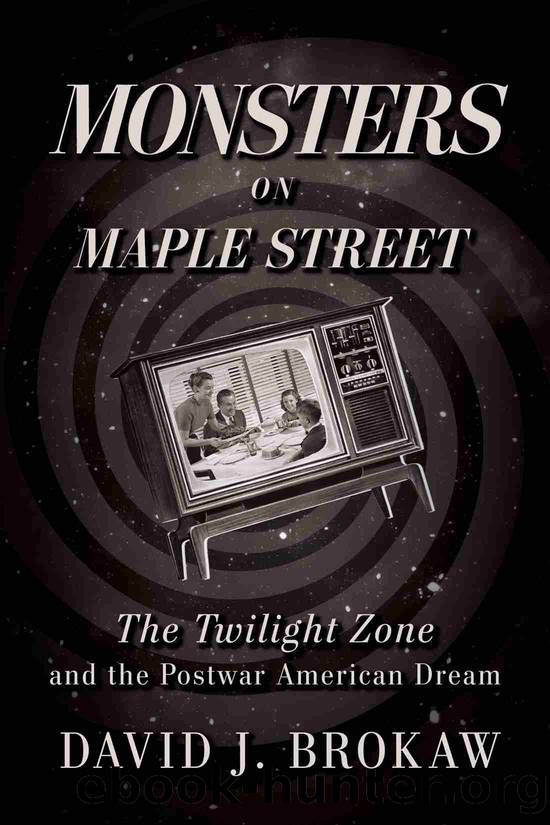Monsters on Maple Street by David J. Brokaw

Author:David J. Brokaw
Language: eng
Format: epub
ISBN: 9780813197869
Publisher: The University Press of Kentucky
5
Cold War Childhood
Containment or Entanglement?
In her seminal study of the postwar return to domesticity, Homeward Bound: American Families in the Cold War Era, Elaine Tyler May convincingly argues how the nuclear family served as the quintessential form of domestic containment, enclosing a wide array of Cold War fears related to nuclear war, Communism, and sexuality: âIn secure postwar homes with plenty of children, American women and men might be able to ward off their nightmares and live out their dreams. The family seemed to be the one place where people could control their destinies and perhaps even shape the future. Of course, nobody actually argued that stable family life could prevent nuclear annihilation. But the home represented a source of meaning and security in a world run amok. Marrying young and having lots of babies were ways for Americans to thumb their noses at doomsday predictions.â Just as raising a family and owning a home in the suburbs represented the epitome of the American Dream, it also helped to ensure that American capitalistic priorities would take precedence among the populace. As developer William Levitt once remarked, âNo man who owns his own house and lot can be a Communist. He has too much to do.â1
Family life was at the heart of many marketing campaigns, which offered guarantees to housewives that postwar products, including home appliances, would free up their time and help them be more attentive mothers. The nuclear family was also the focal point for numerous popular television programs. Shows like Father Knows Best (1954â1960) and Leave It to Beaver (1957â1963) romantically depicted domestic life and traditional gender roles. They also generally showed that when problems did arise, they were easily resolved by everyone simply knowing and returning to oneâs proper place. Consistently, conflicts within television families were simplistic and lacked any complexity or ambiguity. Compromises were easily arranged, and order restored without too much trouble. In the Father Knows Best episode âWoman in the House,â for example, Virge, the wife of one of Jim Andersonâs old friends, comes to stay with the family (S2, e25). Her habits are quickly shown to be undesirable and unfeminine, as she smokes cigarettes, talks about Franz Kafka, and dresses in a semi-bohemian fashion. While tension mounts between her and the Andersons, particularly Margaret, Jimâs wife, the feuding eventually dissipates when Virge embraces traditional feminine roles: helping to care for the children and making mashed potatoes.2 Thus, family conflicts, as well as conflicts with others, were solved when everyone simply knew their role and cheerfully embraced it.
In a rapidly changing postwar world, however, with new middle-class values, white-collar jobs, suburban living, and childhood consumerism suddenly dominating American life, answers to problems did not come quite as easily as they did to the Andersons and Cleavers. Most married women, for example, soon found they could not simply stay at home and take care of their children but had to work as well. And even though the suburbs provided a family-friendly environment, the stresses that
Download
This site does not store any files on its server. We only index and link to content provided by other sites. Please contact the content providers to delete copyright contents if any and email us, we'll remove relevant links or contents immediately.
| Direction & Production | Genres |
| Guides & Reviews | History & Criticism |
| Reference | Screenwriting |
| Shows |
Robin by Dave Itzkoff(2415)
Head of Drama by Sydney Newman(2275)
I'm Judging You by Luvvie Ajayi(2179)
The Paranormal 13 (13 free books featuring witches, vampires, werewolves, mermaids, psychics, Loki, time travel and more!) by unknow(2071)
Ten by Gretchen McNeil(1858)
Single State of Mind by Andi Dorfman(1794)
#MurderTrending by Gretchen McNeil(1639)
Key to the Sacred Pattern: The Untold Story of Rennes-le-Chateau by Henry Lincoln(1613)
Merv by Merv Griffin(1601)
Most Talkative by Andy Cohen(1572)
This Is Just My Face by Gabourey Sidibe(1452)
Notes from the Upside Down by Guy Adams(1450)
The Hunger Games: Official Illustrated Movie Companion by Egan Kate(1412)
Springfield Confidential by Mike Reiss(1393)
Binging with Babish by Andrew Rea(1377)
Jamie Oliver by Stafford Hildred(1376)
The TV Writer's Workbook: A Creative Approach To Television Scripts by Ellen Sandler(1330)
Clarkson--Look Who's Back by Gwen Russell(1328)
Blue Planet II by James Honeyborne & Mark Brownlow(1261)
